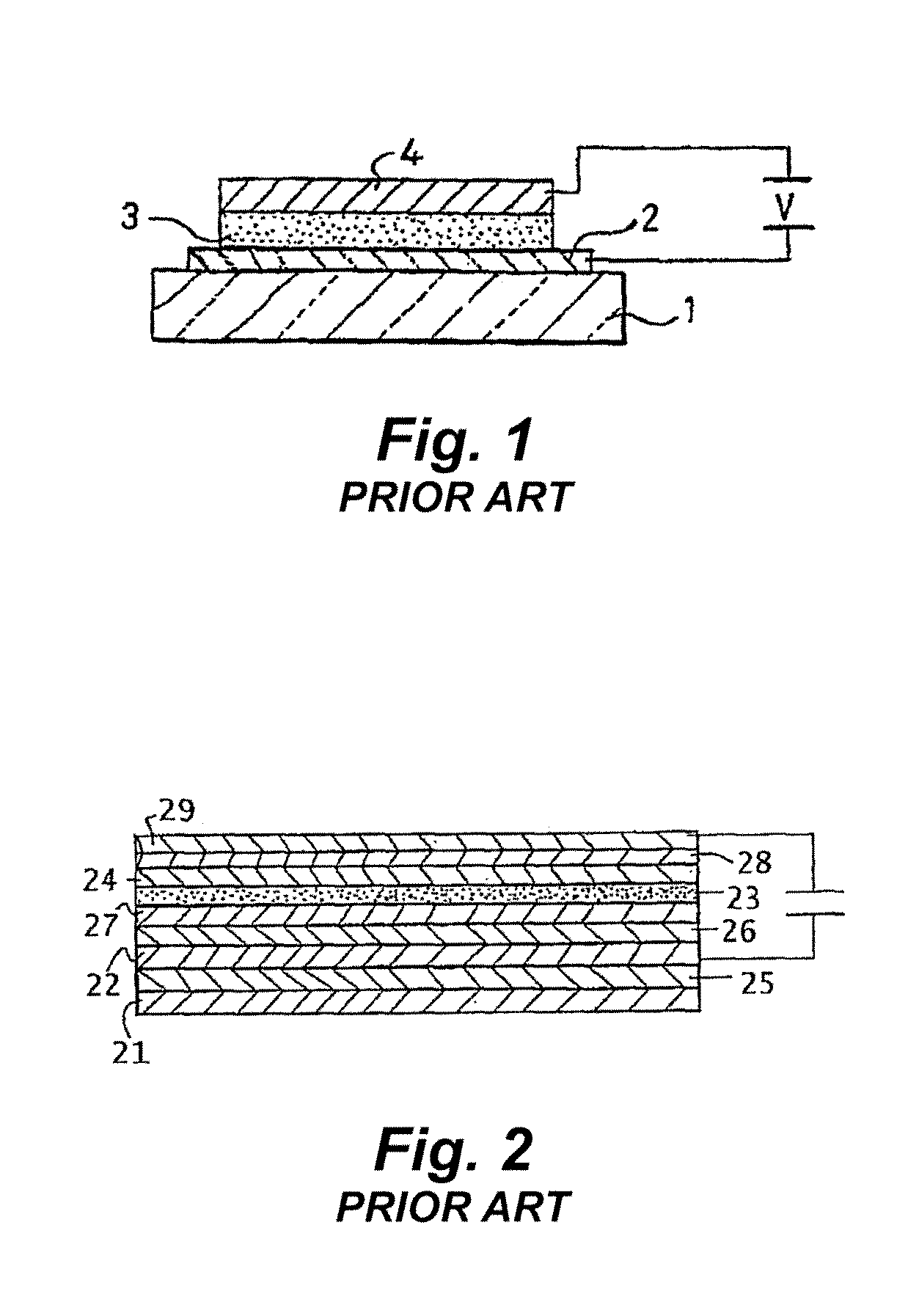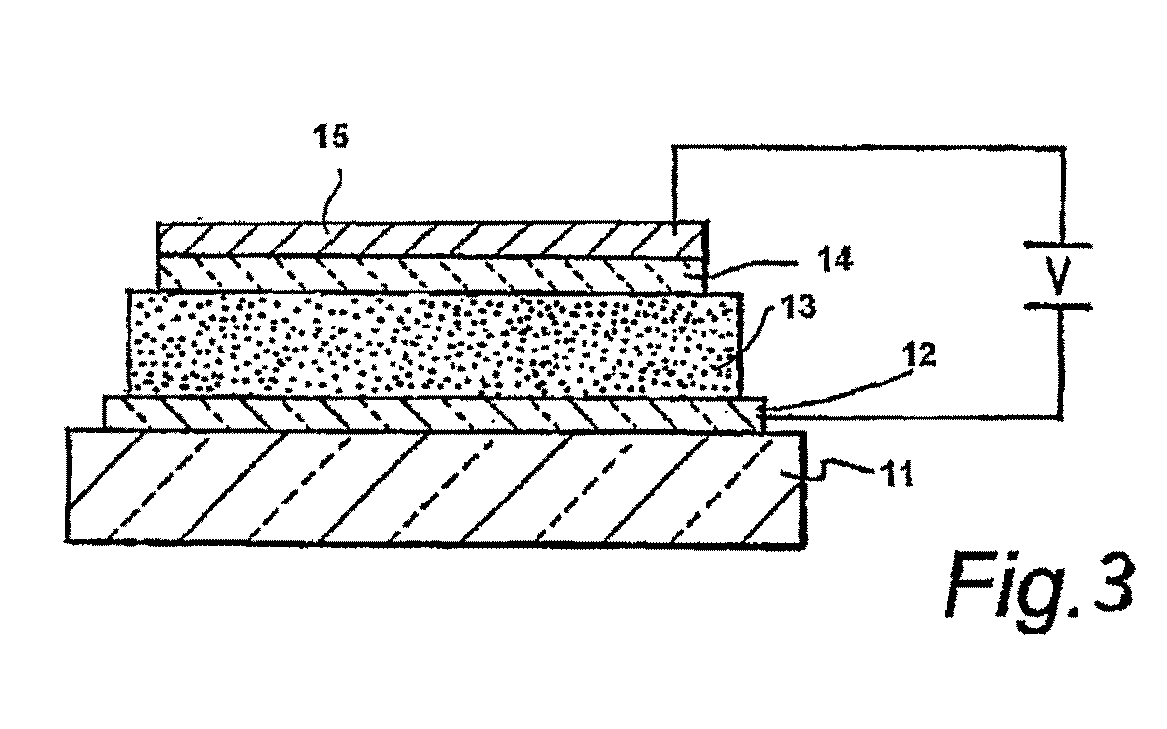Light Emissive Device
a light emissive device and light emissive technology, applied in the direction of discharge tube luminescnet screens, electric discharge lamps, electrical equipment, etc., can solve the problems of high damage to cathode and light emitting layer, adverse effects on cathode transparency, and high damage to cathode and other problems, to achieve the effect of improving the stability of the electrode, low reactivity, and high work function materials
- Summary
- Abstract
- Description
- Claims
- Application Information
AI Technical Summary
Benefits of technology
Problems solved by technology
Method used
Image
Examples
example 1
[0083]Referring to FIG. 3, a layer of PEDT / PSS (not shown) is deposited by spin-coating the formulation Baytron P® available from H C Starck of Leverkusen, Germany onto an indium tin oxide anode 12 supported on a glass substrate 11 (available from Applied Films, Colorado, USA). The PEDT / PSS layer is covered with a layer of a thin film of electroluminescent organic material 13. The organic material is a red-emissive co-polymer comprising repeat units of 9,9-dioctylfluoren-2,7-diyl; 2,1,3-benzothiadiazol-4,7-diyl; and 4,7-bis(2-thien-5-yl)-2,1,3-benzothiadiazole as disclosed in WO 01 / 49768. A composite layer 14 of BaF and Ca or Ba is co-deposited by electron beam co-evaporation, thermal co-evaporation or co-sputtering on organic layer 13. Capping layer 15 of aluminum is applied by electron beam evaporation, thermal evaporation or sputtering. Finally, the device is encapsulated using a metal enclosure available from Saes Getters SpA (not shown) that is glued to the substrate in order t...
example 2
[0084]The process described above was followed except that a full color display was formed according to the process described in EP 0880303 by forming wells for red, green and blue subpixels using standard lithographical techniques; inkjet printing PEDT / PSS into each subpixel well; and inkjet printing red, green and blue electroluminescent materials into wells for red, green and blue subpixels respectively.
[0085]Devices according to the invention provide both good electron injection into the organic layer(s) of the OLED due to the presence of both the low workfunction metal and electron injecting metal compound, and at the same time provides increased stability as compared to a bilayer of the low workfunction metal / metal compound as a result of the metal compound being bound in a matrix of the metal, and consequently being less prone to migration into the organic layers of the device.
example 3
[0086]FIG. 4 shows in diagrammatic form a cross-sectional structure of a top emitting OLED according to the present invention. An anode material 32 such as ITO may be situated on a metal mirror 35 which is positioned over an active matrix back plane 31. Hole transporting material 36 is PEDT / PSS and is situated between anode 32 (ITO) and emissive layer 33. Optionally, a further intermediate layer 37 may be applied between the electron-injecting layer and the light emitting layer.
[0087]Composite combined cathode / buffer layer 34 is deposited over the light emitting layer 33 by electron beam coevaporation or thermal coevaporation. An indium tin oxide layer 39 is deposited by sputtering over the composite layer. Finally, a transparent encapsulation layer (not shown) is applied over the ITO layer so as to protect the device from ingress of oxygen and moisture. The encapsulation layer is generally a dielectric or polymer-dielectric composition.
Transparency Measurement
[0088]According to a f...
PUM
 Login to view more
Login to view more Abstract
Description
Claims
Application Information
 Login to view more
Login to view more - R&D Engineer
- R&D Manager
- IP Professional
- Industry Leading Data Capabilities
- Powerful AI technology
- Patent DNA Extraction
Browse by: Latest US Patents, China's latest patents, Technical Efficacy Thesaurus, Application Domain, Technology Topic.
© 2024 PatSnap. All rights reserved.Legal|Privacy policy|Modern Slavery Act Transparency Statement|Sitemap



